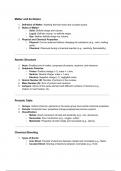Class notes
Chemistry Basics 10
- Course
- Chemistry
- Institution
- 10th Grade
These notes provide an overview of key topics in 10th-grade chemistry, including the structure of matter, the periodic table, types of chemical bonding, reactions and their classifications, acids and bases, metals and nonmetals, carbon compounds, periodic trends, and numerical applications like the...
[Show more]



